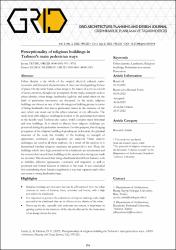Trabzon’un ana yaya bağlantılarında dini yapıların algılanabilirliği
Citation
Yetim, Ş., & Yıldırım, D. Y. (2022). Perceptionality of religious buildings in Trabzon’s main pedestrian ways. GRID Architecture, Planning and Design Journal, 5(2), 193-225. https://doi.org/10.37246/grid.1031014Abstract
Kentsel kimlik, kentlerin özgün fiziksel, kültürel, sosyo-ekonomik, tarihsel
niteliklerinin bütünüdür ve yerin ayırt edici özelliğidir. Kentsel imge ise bir
kente dair duyu, duygu, düşünce ve algılama sonucu oluşan izlerdir.
Çalışmada kentsel kimlik, kentsel imge, işaret öğeleri, okunabilirlik gibi
kavramlar ve yaya hareketiyle algılama temelinde seri görünüm ele
alınmıştır. Kent dokusunda veya kent siluetinde öne çıkabilen kullanıcı
belleğinde kalıcı izler bırakan işaret öğesi olma açısından avantajlı yapı
gruplarından biri olarak dini yapılar seçilmiştir. Çalışma dini yapıları birçok
tarihi ve yeni binayı içinde barındıran, yoğun olarak kullanılan Trabzon
kent merkezinde yaya yollarında yapılan yaya hareketiyle ilişkili ele almıştır.
Yaya hareketi boyunca dini yapıların nasıl algılandığının tartışılması
amaçlanmıştır. Bu amaçla, dini yapının konumuna, yolun fiziksel yapısına,
yapının görülebilirliğine, görünüm gücüne, sürekliliğine ve tekilliğine bağlı
olarak değişen algısı analiz edilmiştir. Tüm bu analizlerde görsel analiz
tekniği kullanılmıştır. Analizler sonucunda dini yapıların algılanıp
algılanmadığı belirlenmiştir. Ardından işaret öğesi olma potansiyeli yüksek
yapılar belirlenerek bu yapıların güçlü ve zayıf algılanmasına neden olan
sebepler ortaya konulmuştur. İşaret öğesi olabilmenin yolla ilişkili olarak
konumsal ve biçimsel özelliklerin yanında görülebilirlik, etkili görünüm,
süreklilik ve tekillik gibi özelliklerin de olması gerektiğini göstermiştir. Bu
özelliklerin bir arada birbirini destekler biçimde ele alınmasının güçlü bir
işaret öğesi oluşturabileceği sonucuna varılmıştır. Urban identity is the whole of the original physical, cultural, socioeconomic and historical characteristics of cities and distinguishing feature
of place. On the other hand, urban image is the traces of a city as a result
of sense, emotion, thought and perception. In the study, concepts such as
urban identity, urban image, landmarks, legibility and serial vision on the
basis of pedestrian movement are discussed. In the study, religious
buildings are chosen as one of the advantageous building groups in terms
of being landmarks that leaves permanent traces in the memory of the
user, which can stand out in the urban structure or city silhouette. The
study deals with religious buildings in relation to the pedestrian movement
in the heavily used Trabzon city center, which contains many historical
and new buildings. It is aimed to discuss how religious buildings are
perceived during the pedestrian movement. For this purpose, the changing
perception of the religious building depending on its location, the physical
structure of the road, the visibility of the building, its strength of
appearance, continuity and singularity are analyzed. Visual analysis
techniques are used in all these analyzes. As a result of the analysis, it is
determined whether religious structures are perceived or not. Then, the
buildings which have high potential to be a landmark are determined and
the reasons that caused these buildings to be perceived as strong and weak
are revealed. This showed that being a landmark should have features such
as visibility, effective appearance, continuity and singularity as well as
positional and formal features in relation to the road. It was concluded
that considering these features together in a way that supports each other
can create a strong landmarks/sign.


















